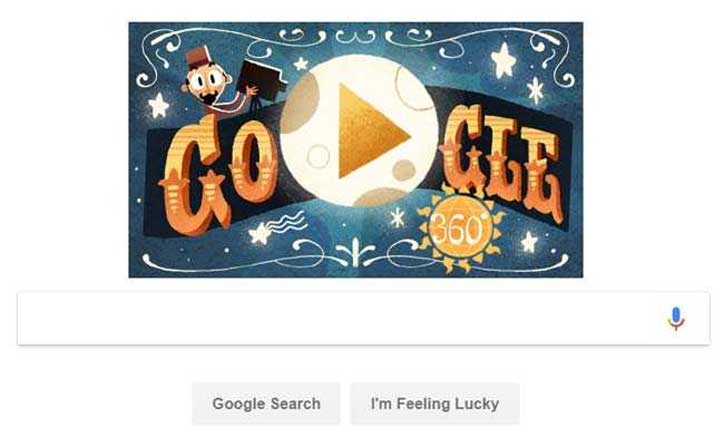 New Delhi:
New Delhi: Today's Google Doodle celebrates French illusionist and film director Georges Melies, who led many technical developments in the earliest days of cinema and popularized the concept of narrative films.
Special cinematic effects are now a reality in almost every piece of cinematic work and we have George Méliès to thank for it. Today marks 116 years since the release date of The Conquest of the Pole, which is considered to be one of George Méliès’ masterpieces. To celebrate the occasion, Google has launched its first-ever virtual reality/360° interactive doodle.
The French illusionist and film director George Méliès pioneered several film techniques to create some of the earliest science fiction films in the history of cinema. When the Lumière brothers showcased their first genuine movies in Paris in 1895, Méliès, a professional magician and manager-director of the Theatre Robert-Houdin at that time, was also among the spectators. Méliès immediately offered the Lumiere brothers money to buy one of their machines. However, the Lumière brothers were anxious to keep a close control on their invention and refused.
But Méliès was not one to accept defeat. He went straight to London and acquired Robert W Paul’s Animatograph film projector for his theatre. With a perforated film, Méliès started to personally develop and print his films through trial and error. By 1897, technology caught up and several better cameras were available in the market. Méliès directed over 500 films between 1896 and 1913, ranging in length from one to forty minutes. His early subject matter was similar to the magic shows, containing tricks and impossible events, such as objects disappearing or changing size. They were mostly devoid of plot.
At the end of 1896, he and Lucien Reulos founded the Star Film Company. With a magician’s intuition, he discovered a number of basic camera tricks: stop motion, slow motion, dissolve, fade-out, superimposition and double exposure. According to Méliès’ memoirs, he discovered the process by accident when his camera jammed in the middle of a take. In 1896, Méliès even built a film studio on his property in Montreuil, just outside Paris. His work became more ambitious and elaborate in the following years. From Christmas pantomimes, political scandals, religious satires to fantasy stories, Méliès had covered almost all the film genres.
Méliès’ most popular work included his various féeries (fairy stories) — Cindrella, Red Riding Hood and Bluebeard. In 1902, Méliès even began to experiment with camera movement to create the illusion of a character changing size. In the same year, he made the film A Trip to the Moon, a space film in which a professor launches six people on a voyage to the moon. At 14 minutes, it was Méliès’ longest film till date and cost 10,000 francs to produce. He even adapted many canonical books to films, from The Damnation of Faust, Gulliver’s Travels Among the Lilliputians and the Giants and Robinson Crusoe. By the early 1900s, Méliès was a hugely popular name in the US as well.
In 1910, Méliès made a deal with Charles Pathé that would eventually destroy his own film career. He accepted a large sum of money and gave up the rights to distribute and edit his films to Pathé Frères. With the money, Méliès started on even more elaborate projects most notably the féerie The Conquest of the Pole in 1912. The film was inspired by contemporary events but had the Méliès’ touch of the fantastical as well. Unfortunately, Conquest of the Pole was not as profitable as his earlier films. Pathé now began editing his films.
He went on to produce féeries like Cinderella or the Glass Slipper, shot with a lot of new technology like new deep focus lenses. But his later work was more or less unprofitable. He broke up with Pathé in 1913 and was submerged in debts.
After the war broke out, a lot of Méliès’ properties were confiscated and used to aid the wounded soldiers. More than hundreds of Star Film prints were even melted down to recover silver and celluloid. In 1923, Pathé was able to take over Star Films and Montreuil studio which led to Méliès destroying a lot of his negatives in a rage. As a result, most of his films are lost, and reportedly, only 200 of them remain.
The 2007 novel The Invention of Hugo Cabret by Brian Selznick and the 2011 film Hugo are based on Méliès’ life. He was also inducted into the Science Fiction and Fantasy Hall of Fame in 2015.
 New Delhi: Today's Google Doodle celebrates French illusionist and film director Georges Melies, who led many technical developments in the earliest days of cinema and popularized the concept of narrative films.
New Delhi: Today's Google Doodle celebrates French illusionist and film director Georges Melies, who led many technical developments in the earliest days of cinema and popularized the concept of narrative films.